Student Leads Excavations in Peru

Throughout the months of June-September of 2015 a team of international researchers led by PhD Candidate, Kimberly Munro and Peruvian archaeologist Jeisen Navarro Vega, under the supervision of Dr. David Chicoine conducted excavations at the Cosma Archaeological Complex, Ancash, Peru. The Cosma site is located at the headwaters of the Nepeña River Valley in the Cordillera Negra Mountains, a branch of the Andes, at an elevation of 2600 MASL. It is a multicomponent site which includes three platform mounds, prehistoric agricultural terraces, domestic areas, a hilltop fortress, and carved Inca stone work.
The previous work in 2014 revealed a Preceramic (3000-1800 BCE) component on the smaller
of the two mounds in the basin, and an Early Horizon (900-200 BCE) presence on the
largest of the mounds, associated with a number of infant burials.
The 2015 excavations were a continuation of the work started the previous year and
focused on the ceremonial temple mounds within the basin. Occupation at the site from
the Late Preceramic ranges through Inca, colonial and modern times. The international
team uncovered more infant burials and large ceramic vessels on the top of the largest
mound, an event that has been preliminarily interpreted as a capping episode – or
sealing event when the mound fell out of use. Below the infants and large ceramic
pots, a tradition of circular stone wall construction associated with burning events
was documented. At the smaller of the two mounds in the basin, one of the most spectacular
finds at the site was documented; a large circular room with a diameter of 6m dating
to the Preceramic period was uncovered. The room had been ritually sealed with rocks
and clay.
While working at the site, Munro and her team lived in the town of Cosma, a small
rural community of indigenous farmers. The team participated in several community
events, helping sponsor festivals, school fundraisers, and helped repair the health
clinic for the community.
The field crew included students from Slovakia, Canada, and the United States, and
collaborators from Tulane University, the University of California-Merced, and the
University of San Marcos in Lima, Peru.
The field season was funded by a National Geographic Society/Waitt Grants Program
awarded to Munro. Excavations will continue next year with funding from a NSF Dissertation
Improvement Grant awarded to Chicoine and Munro.